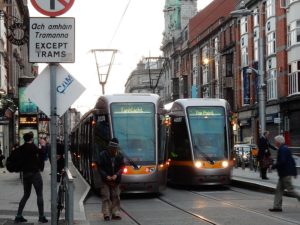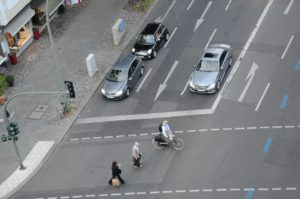💡 Public transport post-pandemic – can it bounce back?
💡 Public transport post-pandemic – can it bounce back?
April 14, 2020: as the coronavirus pandemic brings urban life around the world to a standstill, a webinar organised by NewCities’ The Big Rethink & CoMotion LIVE explored: how can public transport bounce back in the post-COVID-19 urban world?
Chaired by Greg Lindsay, director of applied research, NewCities, the speakers were Mohamed Mezghani, secretary general, UITP; Alice Bravo, director of transportation and public works, Miami-Dade County; and John Siraut, director, Economics, Jacobs Engineering Group.

“This situation has required a lot of communication and reacting quickly,” says Alice Bravo, whose department at Miami-Dade is responsible for a public transport system of over 800 buses on 93 routes, a 40km metro system, a 7km, electric powered people mover (fare-free), and a shared, door-to-door service for people with disabilities. “Over the course of the last five weeks, one thing that really helped a lot was different [transport authority] groups organising national phone or video calls. I recall early on learning what was happening in Seattle. Getting this kind of information helped us better jump start and prepare for the things we’ve done.”
Initial measures taken by Miami-Dade Transit have included stepping up cleaning routines, which also means disinfecting all its buses every night and efforts to install a sanitiser unit in every bus and train. “We then faced the shortage of cleaning products and masks that everyone across the country is facing,” continues Ms Bravo. “But kudos to our procurement department who have managed to get what we need.”

Following in the footsteps of Seattle, more recent actions are suspending fare collection so passengers can board from the rear of buses, “to afford additional protection to our drivers”. Furthermore, buses are being used at half capacity, i.e. every other seat, and live information provided for office-based supervisors enables them to track the number of boardings on each vehicle in real time – “so that extra vehicles can be brought in, if necessary, or to advise the driver not to take on any more passengers,” explains Alice Bravo.
Her department has also formed a partnership with Uber and Lyft to provide night route services for essential trips. In place since 10 April, this free, on-demand ride option, Go Nightly, is available between midnight and 5am.

“To encourage social distancing, we have also changed the logo on our app from ‘Go Miami Bay’ to ‘Don’t Go Miami Bay’, which as a transit director hurt me in my soul, telling people not to use transit,” says Ms Bravo, adding, “overall, our public transport ridership has dropped by 80% or so.”
Miami-Dade Transit takes additional critical steps to ensure safety of workforce and community
“Europe’s seeing a 90% or more fall in public transport ridership,” says Mohamed Mezghani, keen to drive home the vital importance of service continuity to support essential workers and healthcare personnel. “This is why all European countries, except Slovenia, have kept services running.” With regards protective actions, many networks have introduced social distancing measures like in Miami, i.e. stopping cash payment and rear boarding of buses. Also, in Brussels, buses only carry eight passengers and trams 18. “This isn’t just for the benefit of passengers, but for drivers too, who are on the frontline and often there aren’t enough masks or hand sanitisers to protect them,” clarifies Mr Mezghani.
Revenue loss and bailouts – how much, how long?
Governments and authorities are also facing the challenge of supporting public operators by compensating loss in revenue. Here different bailout responses are being adopted. To date at national level, US Congress has earmarked $25 billion dollars for transit agencies nationwide from its $2 billion national Covid-19 emergency aid package. Meanwhile in the U.K., government has come up with a £400 million compensation package to keep the bus sector afloat.

In mainland Europe so far, however, there appear to be no similar financial responses at national level. According to Mohamed Mezghani, this is down to two reasons: European countries are coming out of lockdown at different times plus their public transport systems are organised differently. In the U.K., for instance, the sector is deregulated so bus operators don’t necessarily operate with a contract. Hence without a national bailout package, there is a concern they may cut services, which will have a knock-on effect in keeping essential workers on the move and driving economic recovery. “For deregulated systems, there’s a risk that certain public transport services will be undermined if there’s a lack of funding and passengers,” insists John Siraut.
UK suspends rail franchise system after passenger numbers slide
In most other European countries the tendency is for operators to have service contracts, which means obligations to provide services. In this case, given the current reduced ridership and revenue, these contracts are often being reviewed to see how best to share the risks between transport authorities and their operators. “This is the case in Dublin, where Transdev is operating. It has been agreed to shift from a net cost contract to one that covers costs, plus fixed remuneration to compensate the loss in revenue,” explains Mr Mezghani.

For John Siraut, the fundamental question is how long governments are prepared to step in and keep on supporting the sector. Indeed, public transport in New York and London is currently losing around US$100 million a week while incurring roughly the same fixed operating costs. On the upside, however, Mr Siraut anticipates a fairly quick recovery in ridership in big cities like these, “where alternatives to getting to work like the car are simply impossible, due to congestion and parking issues. But in smaller cities where the car is a more feasible alternative, the return to public transport may well be compromised or slower,” he warns. The worry is that people will shun systems for fear of insufficient social distancing.
Life after lockdown
“What is going back to normal?” questions Alice Bravo. “There’s probably going to be a new normal.” As public transport prepares to resume full services post-lockdown, many people are wondering if there will be any deep-seated changes in urban transport policy, planning, and priorities. For instance, during lockdown cities worldwide have seen significant drops in the number of cars, in noise and air pollution. Traffic congestion is no longer an issue. Urban life has become more pedestrian- and soft mobility-friendly.
So going forward, the question is whether city authorities will want to retain this new, ‘car-free’ order and focus on alternative modes, i.e. shared, active, or carbon-free. “If so, this could be the saving of public transport,” hopes John Siraut.

“It’s vital we maintain service continuity in public transport,” insists Mohamed Mezghani. Indeed, equality and diversity are also at stake. If services are cut, the hardest hit will often be people in low paid jobs who have less or no choice but to use public transport. Whereas those in higher income brackets can opt for cars or taxis, if they so wish.
“We need a public transport system that serves everyone and so creates more equal opportunities,” says Alice Bravo. “Post-Covid-19, at Miami-Dade County we will be continuing our cleaning efforts and focusing on creating the system people want to use. Because we can’t force them,” she acknowledges. “To recover ridership, the quality and frequency of services, the overall level of service, must be improved.”
Continuity of passenger transport services is crucial
In the coming months the big challenge on the ground, reckons Mr Mezghani, will be safeguarding the health of passengers and staff in transport systems. For instance, if social distancing is maintained, who will charged with enforcing it? “Wuhan has introduced safety supervisors to check people are keeping the minimum distance,” he points out. “Also, in Beijing, they are considering introducing a booking system to obtain 10-minute slots for access to public transport stations.”
Another unknown is whether wearing masks in public spaces will become compulsory, as is currently the case in Austria, for example. If so, will the social distancing rule in public transport then be lifted? Mr Mezghani even suggests other measures may well be introduced, like, for instance, guided routing in stations whereby passengers must follow certain pathways – for better crowd management and social distancing. “Going forward, matters like these will depend on the decisions of the health, rather than the transport authorities,” he clarifies. Obviously going forward, cooperation between the two will be key.
15 April – SNCF president calls for masks on trains
In this time of uncertainty, one thing’s for sure: ‘new normal’ is still very much up in the air. One consequence of the Covid-19 crisis may well be greater awareness of the role public transport plays as the backbone of urban mobility. “I hope political leaders will understand the benefits it provides and also realise the importance of workers in this sector,” hopes Mohamed Mezghani, referring to UITP’s ongoing campaign Guardians of Mobility, which seeks to do just this.



